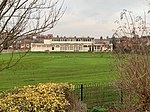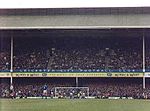2018 Leicester helicopter crash
2010s in Leicester2018 disasters in the United Kingdom2018 in EnglandAccidents and incidents involving the AgustaWestland AW169Aviation accidents and incidents in 2018 ... and 6 more
Aviation accidents and incidents in EnglandEngvarB from October 2018Leicester City F.C.October 2018 events in the United KingdomOud-Heverlee LeuvenSports-related aviation accidents and incidents

An AgustaWestland AW169 helicopter crashed shortly after take-off from King Power Stadium, home ground of Leicester City F.C. in Leicester, England, while on route to Luton Airport on 27 October 2018. All people on board – the pilot and four passengers, including club owner Vichai Srivaddhanaprabha – were killed in the crash. The Air Accidents Investigation Branch attributed the crash to a loss of yaw control owing to a failure of the tail rotor control linkage.
Excerpt from the Wikipedia article 2018 Leicester helicopter crash (License: CC BY-SA 3.0, Authors, Images).2018 Leicester helicopter crash
Filbert Way, Leicester Bede Island
Geographical coordinates (GPS) Address Nearby Places Show on map
Geographical coordinates (GPS)
| Latitude | Longitude |
|---|---|
| N 52.618611111111 ° | E -1.1408333333333 ° |
Address
Filbert Way
LE2 7FQ Leicester, Bede Island
England, United Kingdom
Open on Google Maps









